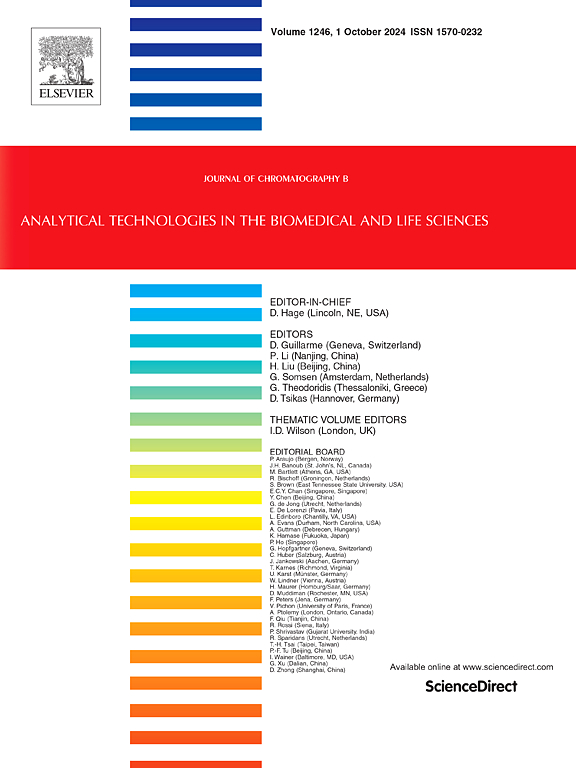免疫亲和层析法制备马破伤风免疫球蛋白F(ab’)2,提高其安全性和有效性
IF 2.8
3区 医学
Q2 BIOCHEMICAL RESEARCH METHODS
引用次数: 0
摘要
通常,抗原特异性抗体占免疫后血清中总IgG的一小部分(通常估计约为2 - 10%)。这种低百分比需要使用纯化技术来丰富用于治疗或研究目的的抗原特异性抗体。本研究引入以nhs活化的Sepharose为基质,以破伤风毒素亚基C (TeNT-Hc-C869A)为配体的亲和层析柱,纯化出高特异性的多克隆抗体。该工艺将抗毒素纯度提高到95%以上,有效中和破伤风毒素,并去除无活性抗体和其他杂质,从而降低由异源蛋白引起的过敏反应的风险。这种方法为预防和治疗破伤风提供了有希望的进展。该亲和柱适用于纯化马血浆、酶解马破伤风F(ab’)2和针对破伤风毒素的人免疫球蛋白。纯化后,这些制剂的特异性活性分别增加了5倍、5倍和30倍,增强了它们的临床安全性。亲和矩阵具有耐用性、高负载能力和无毒性,支持其可扩展性。这种流线型的,具有成本效益的制备工艺突出了该柱在生物制药领域广泛应用的潜力。本文章由计算机程序翻译,如有差异,请以英文原文为准。
Immunoaffinity chromatography for the preparation of equine tetanus immunoglobulin F(ab’)2 for enhanced safety and efficacy
Typically, the antigen-specific antibodies constitute a small fraction—often estimated to be around 2–10 %—of the total IgG in the serum after immunization. This low percentage necessitates the use of purification techniques to enrich the antigen-specific antibodies for therapeutic or research purposes. This study introduces an affinity chromatography column using NHS-activated Sepharose as a matrix and the tetanus toxin subunit C, TeNT-Hc-C869A, as a ligand, enabling the purification of polyclonal antibodies with high specificity. This process improves antitoxin purity to over 95 %, effectively neutralizes the tetanus toxin, and removes inactive antibodies and other impurities, thereby reducing the risk of allergic reactions caused by heterologous proteins. This method offers promising advancements for tetanus prevention and treatment. The developed affinity column is applicable for purifying equine plasma, enzymatically digested equine tetanus F(ab’)₂, and human immunoglobulins targeting the tetanus toxin. Following purification, the specific activities of these preparations increased by factors of 5, 5, and 30, respectively, enhancing their clinical safety profiles. The affinity matrix exhibits durability, high loading capacity, and non-toxicity, supporting its scalability. This streamlined, cost-effective preparation process highlights the column's potential for broad applications in the biopharmaceutical field.
求助全文
通过发布文献求助,成功后即可免费获取论文全文。
去求助
来源期刊

Journal of Chromatography B
医学-分析化学
CiteScore
5.60
自引率
3.30%
发文量
306
审稿时长
44 days
期刊介绍:
The Journal of Chromatography B publishes papers on developments in separation science relevant to biology and biomedical research including both fundamental advances and applications. Analytical techniques which may be considered include the various facets of chromatography, electrophoresis and related methods, affinity and immunoaffinity-based methodologies, hyphenated and other multi-dimensional techniques, and microanalytical approaches. The journal also considers articles reporting developments in sample preparation, detection techniques including mass spectrometry, and data handling and analysis.
Developments related to preparative separations for the isolation and purification of components of biological systems may be published, including chromatographic and electrophoretic methods, affinity separations, field flow fractionation and other preparative approaches.
Applications to the analysis of biological systems and samples will be considered when the analytical science contains a significant element of novelty, e.g. a new approach to the separation of a compound, novel combination of analytical techniques, or significantly improved analytical performance.
 求助内容:
求助内容: 应助结果提醒方式:
应助结果提醒方式:


